Let’s talk about something a lot of people wonder but don’t always get a straight answer to — can copper be soldered to aluminum?
You might be in your garage with a piece of copper pipe in one hand and an aluminum bracket in the other, scratching your head and thinking, “Can I join these two together with solder?” I’ve been there too, and I’ll walk you through everything I’ve learned from experience, trial and error, and advice from seasoned welders and engineers.

Photo by Nthefastlane
This guide is specially written for folks in the USA who are into DIY, home repairs, HVAC work, or just curious about how metal joining works.
If you’re new to soldering or have been working with metal for a while, this article will help you understand the challenges and techniques behind soldering copper to aluminum — and how to do it right.
Why Copper and Aluminum Are Hard to Solder Together
At first glance, copper and aluminum seem like a great pair. They’re both soft, conductive metals and widely used in construction, HVAC systems, and even electronics. When it comes to soldering them together, they don’t play very nicely.
Here’s why:
Different melting points: Copper melts at around 1984°F (1085°C), while aluminum melts at 1220°F (660°C). That’s a big gap.
Oxide layers: Aluminum forms a very stubborn oxide layer that prevents solder from bonding well. Copper also oxidizes but not as aggressively.
Different thermal expansion rates: These two metals expand and contract at different rates when heated and cooled. Over time, that can cause your joint to crack or fail.
So technically, yes — copper can be soldered to aluminum. But it’s not as easy as soldering copper to copper or aluminum to aluminum. You have to take some extra steps to make it work.
What Is Soldering?
Soldering is a process where you use a filler metal (called solder) to join two metals together. The base metals don’t melt. Only the solder melts and flows into the joint to hold them together.
Think of it like metal glue, but with heat. It’s great for electrical connections, plumbing, and HVAC systems.
But not all soldering is the same. When it comes to aluminum and copper, you’re in for a bit of a challenge.
Differences Between Copper and Aluminum
| Property | Copper | Aluminum |
|---|---|---|
| Melting Point | 1984°F (1085°C) | 1220°F (660°C) |
| Oxidation Behavior | Oxidizes slowly | Oxidizes instantly |
| Electrical Conductivity | Very high | High |
| Corrosion Resistance | High | Moderate |
| Workability | Easy to solder and braze | Harder to solder |
These differences mean you need special methods and materials to join them successfully.
Methods for Joining Copper to Aluminum
You can’t just grab a regular soldering iron and some generic solder and expect success. Instead, you’ve got a few specific options that work better. Let me explain each one.
Using a Bimetallic Connector
This is the easiest and safest way to connect copper to aluminum.
A bimetallic connector is a fitting that’s made specifically for joining these two metals. One end is designed for copper, the other for aluminum. The metals inside are separated in a way that prevents corrosion and makes electrical contact stable.
This is especially useful in electrical applications, where connecting copper wires to aluminum wires can otherwise create dangerous heat buildup due to galvanic corrosion.
You’ll often see these used in HVAC and electrical panels.
Soldering with a Special Flux
Now if you really want to solder copper to aluminum directly, this is where things get tricky.
You’ll need:
- A special aluminum flux — this is not your standard rosin or acid flux.
- A solder compatible with both metals — usually a zinc-aluminum alloy.
- A propane or MAP gas torch — standard soldering irons don’t get hot enough for aluminum.
Here’s how I’ve done it before:
- Clean both metals thoroughly. Use a wire brush and degreaser to remove all dirt and oils.
- Apply aluminum flux on the aluminum surface. This helps break through the oxide layer.
- Heat the joint with your torch, being careful not to overheat either metal.
- Apply the solder once the area is hot enough — usually around 700°F.
- Let it cool naturally. Don’t quench it in water or move the joint until it’s fully cooled.
This method requires some practice, and the joint may not be super strong mechanically. But for low-stress applications, it can work.
Use Mechanical Fasteners with Conductive Paste
Another route is not soldering at all, but still making a solid, conductive connection.
You can:
- Bolt or clamp the copper and aluminum together.
- Use an anti-oxidant compound or conductive paste in the joint.
This is common in solar panel wiring, outdoor electrical work, and anywhere dissimilar metals need to touch. It’s a good, safe alternative to soldering, especially when you want to avoid heat.
Use an Explosive Bond or Transition Strip (Industrial Level)
This one’s not for garage DIYers, but it’s worth knowing.
In industrial settings, copper and aluminum can be joined with explosive bonding or by using a solid-state transition strip. This method uses high pressure and sometimes controlled explosions to fuse the two metals.
You’ll find these in heavy-duty electrical buses, power stations, or airplane components. While you won’t be doing this at home, it’s proof that yes — copper and aluminum can be permanently joined.
Potential Problems When Soldering Copper to Aluminum
Even if you follow all the right steps, things can still go wrong. Let me share a few problems I’ve seen:
Galvanic corrosion: When two dissimilar metals are in contact and there’s moisture, one of them corrodes faster. In this case, aluminum corrodes first.
Weak solder joints: If the solder doesn’t flow well, you’ll get a cold joint that fails over time.
Excessive heat: Aluminum conducts heat so well that you might end up overheating the copper while trying to heat the aluminum.
Flux residues: Aluminum flux is very aggressive. If you don’t clean it off properly, it can eat away at the joint over time.
How to Make the Best Joint Possible
Here’s my personal checklist I follow when attempting this:
- Always clean both surfaces right before soldering.
- Use the correct flux and solder for aluminum-to-copper jobs.
- Preheat the aluminum slowly and evenly.
- Don’t move the metals while they’re cooling.
- Use protective gloves and eye protection — aluminum flux can splatter.
- Consider a mechanical backup like a clamp or bracket for added support.
This way, even if the solder joint isn’t perfect, the overall connection will still be solid and reliable.
Applications Where You Might Need This
You may wonder why you’d even want to solder copper to aluminum. Here are some real-life examples I’ve worked on or seen:
- HVAC work: Connecting copper refrigerant lines to aluminum coils.
- Automotive wiring: Sometimes copper leads have to connect to aluminum heat sinks.
- Electrical systems: Joining copper wires to aluminum bus bars or panels.
- DIY electronics: Hobby projects involving custom enclosures or hybrid wiring.
If you know how to do it safely, you can open up a lot of project opportunities.
Summary of Tools and Supplies
| Task | Tool/Supply Needed |
|---|---|
| Clean metal surfaces | Wire brush, degreaser |
| Remove oxide layer | Aluminum-compatible flux |
| Heat source | Propane or MAP gas torch |
| Solder | Zinc-aluminum alloy solder |
| Join support | Clamp, bracket, or mechanical screw |
| Protection | Heat-resistant gloves, goggles |
Alternative Joining Methods Worth Considering
If soldering sounds like too much trouble (and sometimes it is), you can consider:
- Epoxy bonding: Use conductive epoxy for small electrical projects.
- Crimp connectors: Used in wiring — reliable and corrosion resistant.
- Welding (with care): Friction welding or ultrasonic welding can join dissimilar metals in some cases.
- Compression fittings: Great for HVAC and plumbing.
Sometimes, it’s smarter and safer to avoid soldering altogether.
Final Thoughts
So, can copper be soldered to aluminum?
Yes — but it’s not easy, and it’s not always the best option. You need the right tools, right materials, and the right techniques to make it work. And even then, you’ve got to watch out for things like corrosion and weak joints.
If it’s for a simple project or short-term fix, soldering with special flux and solder can get the job done. But for long-term durability, especially in electrical or structural work, bimetallic connectors or mechanical fasteners are a safer bet.
I’ve tried both ways, and when in doubt, I usually lean toward connectors or conductive paste. They’re cleaner, faster, and often last longer — especially if you’re dealing with outdoor environments.
If you’re curious, give it a try. But always be safe, use the right safety gear, and test your connection before calling the job done.
FAQs
Can I solder copper wire directly to aluminum wire?
Yes, but only with special solder and aluminum flux. A better option is to use a bimetallic connector or wire nut approved for dissimilar metals.
What kind of solder do I need for copper to aluminum?
A zinc-aluminum solder or solder designed for dissimilar metal bonding. Regular tin-lead or silver solder won’t work well.
Do I need special flux for soldering aluminum?
Absolutely. Aluminum flux is essential because it breaks down the oxide layer. Regular rosin or plumbing flux won’t work.
Will the joint last a long time?
Not always. Unless it’s done perfectly and kept in a dry, sealed environment, the joint might degrade over time. Mechanical connections are usually more reliable.
Is it dangerous to mix copper and aluminum in electrical work?
It can be. The metals can corrode each other due to galvanic reaction. Always use approved connectors and compounds to prevent fire risks.
Can I use a soldering iron to solder copper to aluminum?
Most soldering irons don’t get hot enough. You’ll need a propane or MAP gas torch to reach the necessary temperature for aluminum soldering.
What’s the easiest way to join copper and aluminum?
Using a bimetallic connector or a mechanical fastener with conductive paste is the easiest and safest way.







